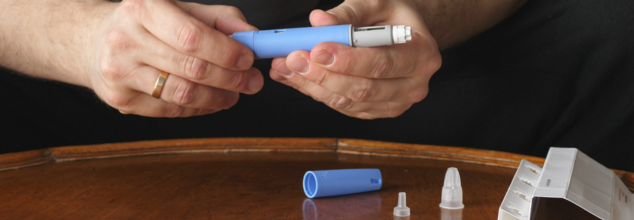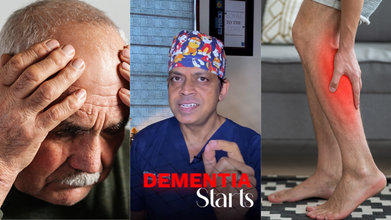- Health Conditions A-Z
- Health & Wellness
- Nutrition
- Fitness
- Health News
- Ayurveda
- Videos
- Medicine A-Z
- Parenting
- Web Stories
Could Weight Loss Jabs Really Put Your Pancreas At Risk? Symptoms, Causes And Treatments You Must Know

(Credit-Canva)
As the number of people reporting pancreatic issues after taking the weight loss and diabetic jabs increases, UK health officials have launched an investigative study to figure out the unexpected side-effects of the drug.
In the UK, the Medicines and Healthcare products Regulatory Agency (MHRA) and Genomics England are asking anyone who was using these shots and ended up in the hospital with a sudden pancreas problem called acute pancreatitis to get in touch. Hundreds of people have reported pancreas issues after taking drugs like Mounjaro, Ozempic, and Wegovy, but doctors haven't yet proven that the shots caused these problems.
The study is part of the MHRA's Yellow Card scheme, this system lets anyone report a problem with a medicine, vaccine, or medical device, which helps doctors find safety issues early. People aged 18 and older who had a serious reaction to these weight loss shots (which are also used for type 2 diabetes) should report it on the Yellow Card website.
They'll then be asked if they want to join the study. This study will check if some people's genes make them more likely to get acute pancreatitis when taking these medicines. Patients will give more information and a saliva sample, hoping to reduce these side effects in the future.
As of May 13 this year, 10 deaths from pancreatitis in people using weight loss drugs were reported to the Yellow Card website, though other health factors might have been involved. It's tough to track exact user numbers since many buy these drugs online without a prescription. While health officials suggest these shots can aid obesity efforts, they caution that they're not a "magic solution" and often cause side effects like nausea, constipation, or diarrhea. The MHRA also warned that Mounjaro could reduce the effectiveness of birth control pills for some users.
Does Weight-Loss Injection Affect Pancreas?
A January 2025 study published in the Nature Medicine had looked into this question before. The study observed how the weight loss drug GLP-1, affected 175 different diseases. The study found that while GLP-1 users saw some benefits, they also had a higher risk of 19 side effects or diseases compared to those on traditional medications.
The most significant finding was that people on GLP-1 agonists were nearly 2.5 times more likely to develop drug-induced acute pancreatitis, a serious condition where the pancreas becomes inflamed.
Other common side effects included a 30% higher risk of nausea or vomiting, an 11% higher risk of arthritis, and a 6% higher risk of low blood pressure. These findings highlight that while beneficial for some conditions, these drugs come with a range of potential risks.
In 2024 a case study published in the journal Cureus, also looked into this, however at the time, they did not have enough evidence to back it. The study explained that some reports had connected Semaglutide to a sudden swelling of the pancreas, called acute pancreatitis. This report talked about a 36-year-old woman who came to the emergency room with sudden, severe stomach pain. She was diagnosed with acute pancreatitis. She had just started using Semaglutide shots for weight loss, which she got from a friend without talking to a doctor first.
After she stopped taking Semaglutide, her pancreas levels (lipase) went back to normal, and her symptoms got much better. This suggests that Semaglutide was likely what caused her acute pancreatitis.
What Is Pancreatitis?
Pancreatitis is inflammation of the pancreas, and this can either be acute or chronic. Finding out whether one has pancreatitis as well as getting it under control is very important as if left unchecked, it can lead to long-term damage and other complications.
As you may know, our pancreas makes important digestive enzymes as well as insulin, which helps us break down glucose components and transform it into energy. Pancreatitis happens when the pancreas enzymes damage the pancreatic tissue itself.
The key difference between acute and chronic pancreatitis is that they are actually different conditions. According to a 2021 study published in the Cureus journal, acute pancreatitis is a sudden, short-term inflammation of the pancreas. When someone has acute pancreatitis, they usually feel severe pain in the upper part of their belly, either in the middle or on the right side. This type of pancreatitis often comes on quickly and, with proper treatment, can resolve. Here are the symptoms, causes and treatment options, according to National Health Services UK.
Chronic pancreatitis is a long-lasting inflammation of the pancreas that often gets worse over time. Unlike acute pancreatitis, the symptoms of chronic pancreatitis can be much broader. People might have ongoing belly pain, but they can also show signs that their pancreas isn't working properly. This can lead to problems with digestion and even diabetes.
Symptoms of Pancreatitis
Acute pancreatitis is a sudden, short-term swelling of your pancreas. The most common signs are severe, sudden pain in the middle of your stomach. You might also feel or be sick, and have diarrhea.
Whereas, the main symptom of chronic pancreatitis is repeated, severe stomach pain, usually in the middle or left side, that can spread to your back. This pain is often described as burning or shooting and can last for hours or days, sometimes without a clear trigger.
As the condition worsens, these painful episodes might happen more often and be more severe. Eventually, you might feel a constant, dull pain in your belly even between bad episodes, especially if you keep drinking alcohol.
Causes of Pancreatitis
Acute pancreatitis happens when digestive chemicals inside your pancreas start to attack the organ itself. It's most often linked to two main things: gallstones, which cause about half of all cases, and drinking alcohol, which is behind about a quarter of cases. You can lower your risk by drinking less alcohol and making diet changes to prevent gallstones.
The most common reason for chronic pancreatitis is drinking too much alcohol for many years. This can cause repeated attacks of sudden pancreatitis, leading to more and more damage. In children, cystic fibrosis is the most common cause. Other less common causes include smoking, your immune system attacking the pancreas, genetic problems, injury, gallstones blocking ducts, or radiation. Sometimes, no cause is found.
Treatment Options for Pancreatitis
Treatment for acute pancreatitis focuses on supporting your body while the swelling goes down. You'll usually need to stay in the hospital for fluids through a vein, pain relief, food support, and oxygen. Most people get better within a week and can leave the hospital in 5 to 10 days, though severe cases might take longer due to complications.
The damage to your pancreas from chronic pancreatitis is permanent, but treatment can help manage the condition and symptoms. Doctors usually advise stopping alcohol and smoking. You'll also get medicine to relieve pain. In some cases of severe pain, surgery might be an option to help control the condition and improve your quality of life.
Researchers have explained that like many other medicines, weight loss jabs also have side-effects, some of which are very serious. The next steps they are taking is to make the medicine safer by gathering more information and helping more personalized prescriptions to prevent any such situation from arising in future.
Why Do I Get Bad Dreams When I Am Sick?

Credits: Canva
What's worse than running nose, continuous sneezing, and a fever? It is the dreams you get when you have finally managed to put yourself to sleep, and those dreams are bad, scary, intense, and negative. Why does this happen?
What Is A Fever Dream?
A dream is basically a series of thoughts, images, sensations that you feel while you are sleeping, and scientists tell us that we have our strongest dreams during the rapid eye movement or the REM of the sleep stage.
Certain factors, including you health could influence your sleep visions and your dreams. A change in body temperature, especially when it is higher than usual could lead to a fever dream, which mostly could be intense, like a nightmare.
As per a 2016 study published in the International Journal of Dream Research, 94 per cent of participants described their fever dreams as negative. Another 2013 study noted that one of the participants had dreams that would move "back and forth between a very difficult circumstance and a very comfortable circumstance." A recent online study in 2020, published in the journal Frontiers Psychology noted that of the 164 participants, 100 of them reported fever dreams. Most of them said that fever dreams were more bizarre, and negatively toned.
While fever dream is known in the medical literature, the scientific studies on the same are limited. Many often describe this as an emotionally intense, troubling, strange, out of character, or a scary dream. The dreams could be the result of less social interactions due to someone being sick.
When Does A Fever Dream Happen?
A fever dream happens when the normal body temperature rises 2 degrees above. The normal body temperature is between 97 and 99 degree F. Anyone can develop a fever, due to the following conditions:
- a viral or bacterial infection
- heat exhaustion
- certain inflammatory conditions such as rheumatoid arthritis
- medicines, such as antibiotics
- an immunization
- a tumor
Why Do You Get Bad Dreams During Fever?
While there is no exact reasoning for it, the 2020 online study notes that the concept behind this is the 'over-heated' brain. High temperature of the body could disrupt the brain's normal cognitive functions. The authors of the 2020 study note, "The basic idea is that the ‘over-heated’ brain is not functioning properly and, therefore, dreams are more bizarre.”
During the REM stage of sleep, the phase where your most vivid dreams unfold, the body already struggles to regulate its internal temperature. When a fever strikes, it disrupts this delicate balance even further, often resulting in intense or disturbing dreams. Fevers can also stir the mind in other unsettling ways, sometimes causing waking hallucinations, irritability, or even brief episodes of confusion.
Dr Mark Rosenblum, who is a sleep psychologist with Hennepin Healthcare, tells CBS News that the reason behind intense dream during sickness is due to REM. He says, "If someone's not getting enough sleep, they get what's called REM rebound on the following nights. And when we have REM rebound, what we'll find is all our dreams tend to be very intense."
Are There Any Symptoms Of Fever Dreams?
As per a 2016 study published in the International Journal of Dream, fever dreams contain some sort of spatial distortion, that include:
- Moving walls
- Creatures with oversized arms and legs
- Metal spheres that move like an organism
- Blackness spreading slowly
- Gigantic insects
Dementia Starts In Your Legs, According To Doctor; What Are The Signs And Tips To Prevent It?

Credits: Instagram and Canva
Bengaluru based neurosurgeon Dr Arun L Naik dropped a video on his Instagram account @doclogues, which has shocked the world, because he says that 'Dementia Starts in Your Legs'.
As of now, most of us knew that it is a general term for a loss of thinking, and is part of normal aging and related to brain diseases that damage the nerve cell. However, Dr Naik notes that as per a 2020 study, it was found that those who walk in a slow speed, especially older adults, were more likely to face the risk of cognitive decline. "Why?" To this, Dr Naik writes that walking is not just a physical task, "it is a full brain workout".
How Is Walking Related To Brain Health? Can Lack Of It Cause Dementia?
Dr Naik writes that there exists a brain-leg connection. "Every step involves coordination between the frontal lobe, cerebellum, spinal cord, and proprioceptive feedback loops."
The second point he notes is of the circulation boost. He writes that leg movement improves blood flow to the brain, and it delivers oxygen, glucose, and clears out toxins.
Then comes gait changes, which the doctor says must be considered as brain warning. It is brain's way to tell that changes in walking style, balance, or pace could proceed to memory symptoms by years.
Lastly, he notes is the neuroplasticity in motion. He says that walking stimulates the brain-derived neurotrophic factor, which strengthens neuron connections. This is why, "weak legs can speed up cognitive decline," he says in his video.
What Study Is The Doctor Quoting When He Says That Dementia Starts From Leg?
The study is a 2020 review, which was published in the Journal of Aging Research. This is where it was seen that older adults, who stay physically active are less likely to develop cognitive decline or dementia. The study analyzed over 1,60,000 people and found that regular exercise reduced the risk of dementia by 28 per cent and Alzheimer's disease by 45 per cent.
With aging, especially from mid-50s, most adults begin to lose 1 to 2 per cent of muscle mass every year, this process is further accelerated by inactivity. This loss then not only affects mobility, but also metabolism and blood circulation, which results in less oxygen reaching to your brain, as the doctor also explained.
This is why the doctor says, "if your legs slow down, your brain may follow".
Can Something Be Done To Prevent Dementia?
The answer is yes. Dr Naik also says, "studies have shown that it is never too late to start. Starting even in your 60s can reduce dementia risk by a mile". So, what is he asking people to start? He is urging people to start some activity, to help their bodies move, and enable the brain to leg coordination.
The doctor also notes some "strategies" to prevent dementia in the caption of his post through movements, which are as followed:
- Walk 30 minutes daily at a brisk pace.
- Add balance exercises like tandem walking and single-leg stands.
- Practice dual-task walking (e.g. walking while talking or solving a simple mental task).
- Include strength training for lower limbs—muscle is cognitive insurance.
- Avoid long periods of sitting—movement every hour keeps memory sharp.
Fact Check: Does Cracking Your Knuckles Every Day Damage Your Joints?

Credits: Canva
If you are someone who cracks your knuckles every day just for that oddly satisfying pop, you are not alone. For many, the sharp sound brings a fleeting sense of relief or relaxation. Yet, there has long been a debate about whether this seemingly harmless habit could actually damage your joints or raise the risk of arthritis.
For those unversed, the pop you hear when cracking your knuckles comes from gas bubbles in the joint fluid collapsing. For most people, it’s harmless, though it can occasionally cause slight swelling or a temporary drop in grip strength. The long-standing belief that it leads to arthritis is not backed by science, but using too much force could result in minor injuries, like ligament sprains or dislocations
Addressing this common worry, orthopedic surgeon Dr. Manan Vora answered the question in a viral reel that has now surpassed 2.5 million views. A viewer asked him, “Can cracking knuckles every day lead to arthritis?”
Dr. Vora said, “The pop you hear when cracking a knuckle is the sound of these bubbles bursting within the synovial fluid inside the joint,” he clarified.
Is Cracking Knuckles Bad For You?
Knuckle cracking is a habit many pick up early in life, often because they enjoy the sound or the temporary feeling of looseness in the fingers. According to the Johns Hopkins Arthritis Center, the sound comes from changes inside the joint capsule, which is filled with synovial fluid. This fluid not only lubricates the joints but also nourishes the surrounding bones.
“A variety of gases are dissolved in this fluid. When a knuckle is cracked, stretching the capsule lowers the pressure inside, creating a vacuum. The dissolved gases form a bubble, which bursts, producing the familiar popping sound. It takes time for the gases to re-dissolve, which is why you can’t immediately crack the same knuckle again,” Johns Hopkins adds.
Does Cracking Knuckles Cause Arthritis?
Many worry that frequent knuckle cracking could trigger arthritis. However, research shows there is no evidence linking the habit to arthritis or long-term joint damage. A few reports have noted that excessive cracking may occasionally cause minor ligament strains or tendon dislocations, but these injuries typically heal on their own.
Some studies also suggest that habitual knuckle crackers might have slightly reduced grip strength over time, but this does not equate to arthritis. Rarely, “knuckle pads” can develop in young people who crack their knuckles often, but these are mostly cosmetic.
Several studies back up the conclusion that knuckle cracking does not cause arthritis. For example, a study by the Uniformed Services University of the Health Sciences followed 215 participants, 20% of whom regularly cracked their knuckles. They found arthritis in 18.1% of knuckle crackers and 21.5% of non-crackers, essentially the same rate, showing no link between the habit and the disease.
A famous anecdote comes from Dr. Donald Unger, who cracked the knuckles on his left hand twice daily for 50 years while leaving his right hand untouched. Published in Arthritis and Rheumatism in 1998, the informal experiment revealed that neither hand showed signs of arthritis. More recent studies in 2017 reached similar results, finding no difference in hand function between people who cracked their knuckles and those who didn’t.
What Is Arthritis?
Arthritis is a condition that causes inflammation and pain in one or more joints, often leading to stiffness and limiting the joint’s range of motion. Genetics play a major role, with environmental triggers contributing to inflammatory types, and age or mechanical stress driving degenerative arthritis.
Other risk factors include obesity, previous joint injuries, family history, older age, and being female. But as research confirms, knuckle cracking is not one of them.
© 2024 Bennett, Coleman & Company Limited

